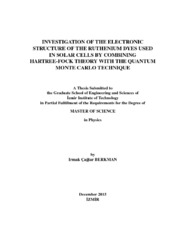Please use this identifier to cite or link to this item:
https://hdl.handle.net/11147/4552| Title: | Investigation of the Electronic Structure of the Ruthenium Dyes Used in Solar Cells by Combining Hartree-Fock Theory With the Quantum Monte Carlo Technique | Other Titles: | Güneş Pillerinde Kullanılan Ruthenium Boyaların Elektronik Yapısının Hartree-fock Kuramı ile Kuantum Monte Carlo Tekniğinin Birleştirilerek İncelenmesi | Authors: | Berkman, Irmak Çağlar | Advisors: | Bulut, Nejat | Keywords: | Hartree-Fock approximation Monte Carlo method Anderson model Solar cells Ruthenium |
Publisher: | Izmir Institute of Technology | Source: | Berkman, I. Ç. (2015). Investigation of the electronic structure of the ruthenium dyes used in solar cells by combining Hartree-Fock Theory with the Quantum Monte Carlo technique. Unpublished master's thesis, İzmir Institute of Technology, İzmir, Turkey | Abstract: | The Haldane-Anderson model is constructed to describe the electronic properties of a system where a transition-metal impurity atom is added into a semiconductor host material. The electric and magnetic properties of the ruthenium-based dyes are investigated by using Haldane-Anderson model in this study. Because ruthenium-based dyes are semiconductor and ruthenium atom is a transition metal and its 4d orbitals are considered as impurities for dye molecules. Density Functional Theory (DFT) and Hartree-Fock Theory (HF) was used to obtain the Haldane-Anderson model parameters of the ruthenium-based dyes. Multi-orbital Hirsch-Fye Quantum Monte Carlo (HFQMC) algorithm was used to investigate effect of onsite Coulomb interactions of impurity 4d orbitals. Firstly, the Anderson model parameters are calculated by using Hartree-Fock and Density Functional Theory. After that, the occupation numbers of 4d orbitals and the all orbital occupancies of the dye molecules are obtained by using the Hirsch-Fye Quantum Monte Carlo algorithm and the magnetization of 4d orbitals are calculated. Finally, physical meaning of our results are discussed. Yarı-iletken ev sahibi malzemenin içine geçiş metali safsızlık atomu eklenerek oluşturulan bir sistemin elektronik özelliklerini incelemek için Haldane-Anderson modeli oluşturulmuştur. Bu çalışmada ruthenium-temelli boyaların elektronik ve manyetik özellikleri Haldane-Anderson modeli kullanılarak incelenmiştir. Çünkü, ruthenium-temelli boyalar yarı iletkendir ve ruthenium atomu bir geçiş metalidir ayrıca ruthenium atomunun 4d orbitalleri boya molekülü için safsızlık olarak kabul edilmiştir. Ruthenium-temelli boyaların Haldane-Anderson modeli parameterelerini elde etmek için Yoğunluk Fonksiyoneli Kuramı ve Hartree-Fock Kuramı kullanılmıştır. 4d orbitallerindeki Coulomb etkiles¸- melerinin sistemin elektronik özelliklerine etkisini incelemek için multi-orbital Hirsch- Fye Quantum Monte Carlo algoritması kullanılmıştır. İlk olarak, Hartree-Fock ve Yoğunluk Fonksiyoneli Kuramları kullanılarak Anderson modeli parametreleri hesaplanmıs¸tır. Bundan sonra, Hirsch-Fye Kuantum Monte Carlo algoritması kullanılarak 4d orbitallerinin doluluk oranları, bütün sistemin doluluk oranları ve 4d orbitallerinin manyetizasyonları elde edilmiştir. Son olarak sonuçlarımızın fiziksel anlamları tartışılmıştır. |
Description: | Thesis (Master)--Izmir Institute of Technology, Physics, Izmir, 2015 Includes bibliographical references (leaves: 58-61) Text in English; Abstract: Turkish and English xiii, 86 leaves |
URI: | http://hdl.handle.net/11147/4552 |
| Appears in Collections: | Master Degree / Yüksek Lisans Tezleri |
Files in This Item:
| File | Description | Size | Format | |
|---|---|---|---|---|
| T001416.pdf | MasterThesis | 4.23 MB | Adobe PDF |  View/Open |
CORE Recommender
Page view(s)
238
checked on Mar 10, 2025
Download(s)
138
checked on Mar 10, 2025
Google ScholarTM
Check
Items in GCRIS Repository are protected by copyright, with all rights reserved, unless otherwise indicated.